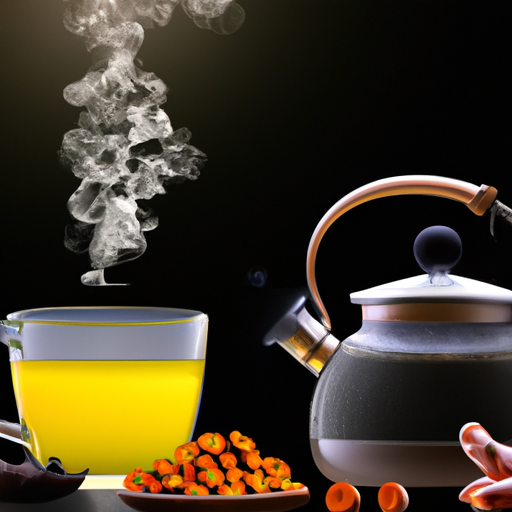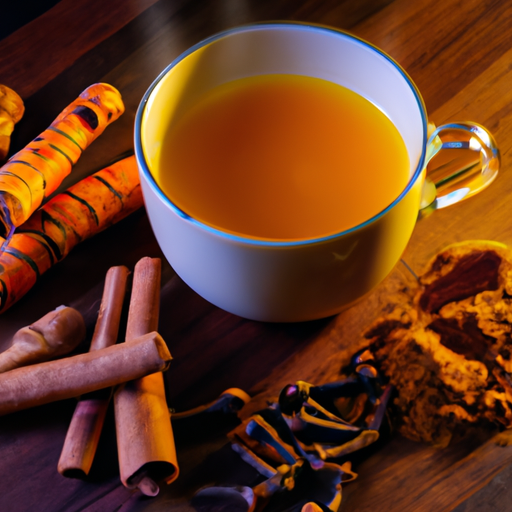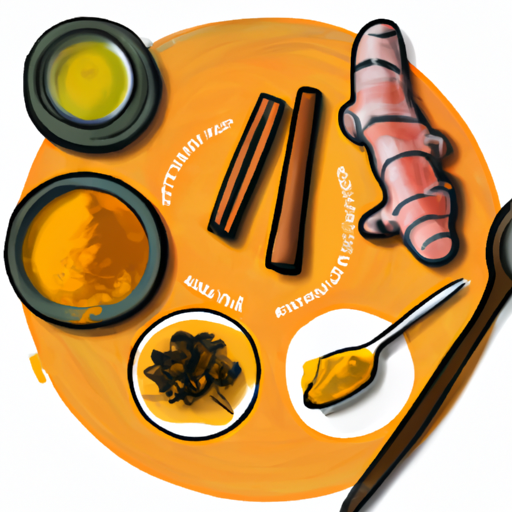Hello! Are you in search of a simple yet scrumptious method to add turmeric to your daily habits? Search no more, as turmeric tea is your answer! It’s not only flavorful but also comes with a variety of health advantages, such as diminishing inflammation and enhancing digestive health.
But how do you steep the perfect cup of turmeric tea? First, choose the right kind of turmeric – fresh or powdered will work. Then, prepare the turmeric by peeling and grating fresh root or measuring out the appropriate amount of powder.
From there, choose any additional ingredients you’d like to add before boiling water and allowing it to steep with the turmeric. Finally, strain the tea and add honey or other sweeteners as desired before enjoying your warm and cozy cup of goodness.
Keep reading for a step-by-step guide on how to steep turmeric tea that’s sure to become a staple in your daily routine!
Key Takeaways
- Boiling water is essential to extract nutrients from the ingredients.
- Adding ginger root or black pepper helps increase the bioavailability of curcumin.
- Allow the tea to steep for at least 10 minutes for maximum flavor and health benefits.
- Strain the tea to remove remaining pieces of turmeric or spices.
Benefits of Turmeric Tea
You’ll love the amazing benefits of turmeric tea, which can help reduce inflammation and boost your immune system! Turmeric has long been used in traditional medicine to treat a variety of ailments. Its active ingredient, curcumin, is known to have anti-inflammatory properties that can help alleviate pain and swelling in the body.
Drinking turmeric tea regularly may also help boost your immune system, thanks to its antioxidant content. Making your own turmeric tea at home is easy with a few simple turmeric tea recipes and brewing techniques. You can use fresh or ground turmeric root, depending on what you have available.
There are many variations of turmeric tea recipes out there, so feel free to experiment until you find one that suits your taste buds. But before we dive into the recipe details, let’s talk about choosing the right turmeric for your tea.
Choosing the Right Turmeric
Sure, go ahead and pick the cheapest turmeric you can find at the grocery store. Who cares about quality when it comes to your health, right? Wrong! The key to making a delicious cup of turmeric tea is choosing quality turmeric.
Look for fresh, whole turmeric roots that are firm and free of blemishes or mold. If you can’t find fresh turmeric, opt for high-quality ground turmeric powder from a reputable brand.
Once you’ve chosen your turmeric, make sure to store it properly to maintain its potency. Store fresh turmeric in the refrigerator in an airtight container or plastic bag for up to two weeks. Ground turmeric should be stored in a cool, dry place away from direct sunlight in an airtight container for up to six months.
By selecting quality turmeric and storing it properly, you’ll be on your way to brewing a flavorful cup of healthy and nourishing tea that will give you all the benefits this amazing spice has to offer.
Now that we have our high-quality turmeric ready, let’s move on to preparing it for steeping into tea.
Preparing the Turmeric
When it comes to preparing turmeric for tea, I prefer to use fresh turmeric root.
To do this, I start by grating the turmeric using a fine grater. This allows the turmeric to release its flavor and color more easily into the hot water.
If I don’t have fresh turmeric available, I will slice dried turmeric instead. This still produces a flavorful tea but may require a longer steeping time.
Grating fresh turmeric
To start grating fresh turmeric, simply take a small piece and rub it against a fine grater in a circular motion. Here are some tips to make the process easier and more efficient:
- Use gloves to avoid staining your hands with turmeric’s yellow pigment.
- Choose fresh turmeric over dried ones as they’re easier to grate and have a brighter color.
- Grate the turmeric directly onto a cutting board or plate to avoid losing any of its juice.
- If you don’t have a grater, use a sharp knife to slice the turmeric thinly instead.
Incorporate grated fresh turmeric into dishes like curries, soups, or smoothies for maximum health benefits.
Now that you’ve grated your fresh turmeric, it’s time to move on to the next step: slicing dried turmeric.
Slicing dried turmeric
If you’re using dried turmeric, take a piece and imagine the satisfying sound of it snapping as you break it into smaller chunks with your fingers. The beauty of using dried turmeric is that it lasts longer than fresh turmeric, and you can use it for different purposes.
You can slice it thinly or grate it to add flavor to your dishes, soups, or stews. Dried turmeric also has health benefits such as being anti-inflammatory, aiding digestion, and boosting immunity.
Apart from steeping turmeric tea with sliced dried turmeric, you can also choose other ingredients to enhance its flavor. For instance, adding ginger root or black pepper helps increase the bioavailability of curcumin in the body. This means that more curcumin gets absorbed into your bloodstream when consumed together with these ingredients.
So now that we’ve talked about slicing dried turmeric, let’s move on to choosing other ingredients to make a delicious cup of tea!
Choosing Other Ingredients
When choosing other ingredients to add to my turmeric tea, I like to consider ginger for its anti-inflammatory properties and spicy kick.
Cinnamon is also a great option, as it adds a sweet flavor while helping to regulate blood sugar levels.
Lastly, honey is a natural sweetener that can provide additional health benefits such as antibacterial properties and soothing effects on sore throats.
By adding these ingredients, I can enhance the flavor of my turmeric tea while also reaping the benefits of their nutritional value.
Ginger
Ginger’s spicy and zesty flavor adds a delightful kick to turmeric tea. Not only does it enhance the taste, but it also comes with its own set of health benefits. If you’re looking for something to spice up your tea game, consider adding ginger to your brewing process.
Here are four ways that ginger can make your turmeric tea even better:
- The combination of ginger and turmeric creates a powerful anti-inflammatory drink.
- Ginger is known for soothing upset stomachs and aiding in digestion.
- The spicy heat from ginger can help clear congestion and alleviate cold symptoms.
- Ginger has natural antibacterial properties which can strengthen the immune system.
Moving on to our next ingredient – cinnamon!
Cinnamon
After learning about the benefits of ginger in our previous subtopic, let’s move on to cinnamon. Cinnamon is a spice commonly used in baking and cooking. It has a sweet and warm flavor that can enhance the taste of any dish. Moreover, it also offers numerous health benefits.
Cinnamon has been found to have anti-inflammatory properties that can help reduce inflammation in the body. It is also known to lower blood sugar levels and improve insulin sensitivity, making it a great addition for people with diabetes or pre-diabetes. Furthermore, studies have shown that cinnamon may help improve brain function and memory retention. In terms of culinary uses, cinnamon is often used in desserts such as apple pie or cinnamon rolls, but it can also be added to savory dishes like curries or stews for a unique twist on traditional flavors.
| Health Benefits | Culinary Uses | Fun Fact |
|---|---|---|
| Anti-inflammatory properties | Baking (e.g., apple pie) | Cinnamon was once more valuable than gold! |
| Lowers blood sugar levels | Cooking (e.g., curries) | There are two main types of cinnamon: Ceylon and Cassia |
| Improves brain function | Can be added to coffee or tea for extra flavor | The aroma of cinnamon can boost cognitive function |
As we continue our journey on how to steep turmeric tea, our next ingredient will be honey.
Honey
Let’s dive into the sweet and golden world of honey, a natural sweetener that’s not only delicious but also offers numerous health benefits. Here are some interesting facts you may not know:
- Honey has antibacterial properties that can help heal wounds and soothe sore throats.
- It contains antioxidants that can protect your cells from damage caused by free radicals.
- Raw honey can help reduce allergies by introducing small amounts of pollen into your system.
- There are many different types of honey available, each with its own unique flavor profile.
If you’re looking for a vegan alternative to honey, you might try using maple syrup or agave nectar instead.
When making turmeric tea, I always prefer to use raw honey as a natural sweetener. Not only does it add a lovely sweetness to the tea, but it also provides additional health benefits.
Now that we’ve learned about the benefits of using honey in our tea, let’s move on to boiling the water.
Boiling the Water
First, fill a pot with water and bring it to a boil. Boiling the water is an essential step in making turmeric tea as it helps to extract the nutrients from the ingredients. When boiling the water, make sure to use a pot with enough space for the water level to rise without overflowing. It’s also important to pay attention to boiling tips, such as keeping an eye on the temperature of the water.
When bringing the water to a boil, wait until you see bubbles forming at the bottom of your pot before adding any ingredients. This will ensure that your tea will be infused with all of its flavors and properties.
Once you’ve boiled your water, you can move onto adding your turmeric and other ingredients for maximum taste and health benefits.
Adding the Ingredients
Now it’s time to infuse your boiling water with the powerful blend of spices and herbs that will give your tea its unique flavor profile and health benefits. To begin, gather your turmeric root, ginger root, black pepper, cinnamon stick and honey. These ingredients will not only enhance the taste of your tea but also provide a range of health benefits such as anti-inflammatory properties and aiding digestion.
Mixing techniques are important to ensure the flavors are well distributed throughout the tea. Start by grating or finely chopping half an inch of fresh turmeric root and ginger root each. Add them to the boiling water along with a pinch of black pepper for better absorption of turmeric’s curcumin compound. For an added hint of sweetness, stir in a teaspoon of honey or other natural sweeteners like maple syrup or stevia. Finally, add a cinnamon stick to balance out all the flavors and aromas.
With all ingredients combined, let the mixture simmer on low heat for about 10-15 minutes before straining it into a cup. The longer you steep it, the stronger the flavors will be but avoid over-steeping as it can make your tea bitter. In order to fully enjoy this deliciously healthy beverage, let’s move on to our next step: letting it steep!
Letting it Steep
Now that we’ve added the ingredients to our turmeric tea, it’s time to let it steep.
The ideal steeping time for turmeric tea is around 10-15 minutes, but this can vary based on personal preference.
It’s important to cover the tea while it steeps to keep in the heat and prevent any flavors from escaping.
Ideal steeping time
To get the perfect cup of turmeric tea, you gotta let it steep for at least 10 minutes, but don’t worry about being too precise with your timing – it’s not rocket science.
However, there are some factors that can affect the ideal steeping time for turmeric tea. For example, the quality and age of the turmeric used can play a role in how long it needs to steep. Additionally, if you’re using loose leaf turmeric instead of teabags, you may need to adjust your steeping time accordingly.
To test for optimal steeping time, simply taste your tea after 10 minutes and see if it has reached your desired level of flavor and strength. If not, continue to let it steep in increments of 1-2 minutes until you achieve your desired result. It’s important to note that oversteeping can lead to bitter or unpleasant flavors in your tea, so be mindful not to leave it sitting too long.
When covering the tea while it steeps (which we’ll discuss next), make sure to use a lid or cover that fits well on your mug or pot without letting steam escape.
Covering the tea while it steeps
Using a properly fitting lid to cover the brewing beverage can help enhance the flavor and aroma of the final product. Covering tea while it steeps not only prevents evaporation, but also traps in essential oils and volatiles that contribute to its taste and aroma.
Here are some tips on covering your turmeric tea while it steeps:
- Use a lid or cover that fits snugly on top of your teapot or mug.
- If you don’t have a lid for your container, use a saucer or plate instead.
- Avoid using plastic wrap as it may release harmful chemicals when heated.
- Make sure to remove the lid or cover only when the steeping time is complete to avoid losing any aromatic compounds.
Now that you know how to properly cover your turmeric tea while it steeps, let’s move onto straining the tea for optimal enjoyment.
Straining the Tea
After letting the turmeric tea steep for a few minutes, simply pour it through a strainer to remove any remaining pieces of turmeric or other spices. I prefer using a fine mesh strainer that catches all the small particles and allows the tea to flow through smoothly.
However, if you don’t have one, there are alternative strainers available in your kitchen that can be used such as cheesecloth or coffee filters.
Once you have strained the tea, you can now add honey or other sweeteners to taste. It’s best to wait until after straining so that any added sweetener doesn’t get caught in the strainer and go to waste.
So let’s move on to adding sweetness to our delicious turmeric tea!
Adding Honey or Other Sweeteners
Now that we’ve properly steeped our turmeric tea, let’s talk about adding honey or other sweeteners to enhance the flavor.
Personally, I love using honey as it not only adds sweetness but also has numerous health benefits such as being a natural antibacterial and anti-inflammatory agent.
However, there are many other sweeteners you can consider such as agave nectar, stevia, or maple syrup depending on your preference and dietary restrictions.
Benefits of honey
Honey holds helpful health benefits for those who enjoy sipping on some turmeric tea. In addition to its sweet taste, honey is known for its antibacterial and antioxidant properties that can support a healthy immune system. It also has anti-inflammatory properties that are beneficial to those with joint pain or digestive issues.
Apart from its health benefits, honey is also a versatile ingredient in the culinary world. It can be used as a natural sweetener in various recipes such as marinades, dressings, and desserts. Its unique flavor profile also makes it an ideal pairing for turmeric tea. So not only does honey offer medicinal value, but it can also enhance the taste of your cuppa!
As much as honey is an excellent option when steeping turmeric tea, there are other sweeteners to consider that can provide similar advantages without altering the flavor too much.
Other sweeteners to consider
Incorporating alternative sweeteners into your drink can provide similar health benefits and enhance the flavor profile of your cup. Agave nectar is a natural sweetener derived from the agave plant that is low on the glycemic index, making it a great option for those watching their blood sugar levels. It also contains trace amounts of vitamins and minerals like calcium, potassium, and magnesium. A little goes a long way when using agave nectar as a sweetener for turmeric tea, so start with small amounts and adjust to taste.
Another alternative sweetener to consider is stevia, which comes from the leaves of the stevia plant. Stevia is calorie-free and up to 300 times sweeter than sugar, making it an excellent choice for those looking to reduce their caloric intake or avoid added sugars altogether. It’s important to note that stevia has a slightly different taste profile than sugar or honey, so experiment with small amounts first before adding more.
Both agave nectar and stevia are great options for those looking to add sweetness to their turmeric tea without compromising their health goals.
As you finish steeping your turmeric tea with your preferred sweetener, take some time to relax and enjoy its warm flavors. Whether you’re sipping on it in the morning or winding down at night, this golden elixir offers numerous health benefits while providing comfort through its soothing warmth.
Enjoying Your Turmeric Tea
To fully savor the benefits of turmeric tea, I highly recommend adding a touch of black pepper to your brew. This is because black pepper contains piperine, a compound that has been shown to increase the absorption of curcumin by up to 2,000%. Curcumin is the main active ingredient in turmeric and is responsible for its many health benefits.
In addition to enhancing the absorption of curcumin, there are other ways to enjoy turmeric tea. You can pair it with food like a savory breakfast bowl or oatmeal topped with nuts and fruits. Alternatively, you can sweeten it up with honey or maple syrup and enjoy it as an afternoon treat.
Experimenting with different flavors and pairings can elevate your turmeric tea experience and make it more enjoyable overall.
Frequently Asked Questions
Can turmeric tea help with weight loss?
I’ve found that drinking turmeric tea can aid in weight loss by boosting metabolism. The benefits of turmeric include anti-inflammatory properties and an increase in antioxidant levels, making it a great addition to any diet.
Does turmeric tea have any negative side effects?
As with any supplement, it’s important to be aware of potential side effects when consuming turmeric tea. It’s recommended to start with a low dosage and gradually increase. Common side effects may include stomach upset or allergic reactions.
Is it safe to consume turmeric tea while pregnant or nursing?
As a pregnant or breastfeeding mother, it is important to exercise caution when consuming turmeric tea. While it may offer health benefits, its safety during pregnancy and breastfeeding has not been thoroughly researched. Consult with your healthcare provider before consuming turmeric tea.
How often should I drink turmeric tea to reap its health benefits?
I drink turmeric tea daily to reap its health benefits. The best time to drink it is in the morning or before bedtime. I recommend starting with a small turmeric tea dosage and gradually increasing it based on personal preference.
Can I use powdered turmeric instead of fresh turmeric root for making turmeric tea?
Using powdered turmeric for tea is like using a shortcut- it’s easier but lacks the full benefits. Fresh turmeric root has more antioxidants and curcumin, improving digestion and reducing inflammation.
Conclusion
Overall, steeping turmeric tea is a simple process that can lead to many health benefits. By choosing the right turmeric and preparing it properly, you can create a delicious and nutritious beverage that can help with inflammation, digestion, and more. Adding other ingredients like ginger or cinnamon can enhance the flavor even further.
But let’s be real here – turmeric tea may not be everyone’s cup of tea (pun intended). Some people may find the taste too strong or bitter. However, with a little bit of honey or another sweetener added in, the taste can be easily adjusted to one’s liking.
And even if you don’t love the taste of turmeric tea, incorporating this spice into your diet through other means (like adding it to curries or smoothies) can still offer many health benefits.
So go ahead and give turmeric a try – your body will thank you for it!









